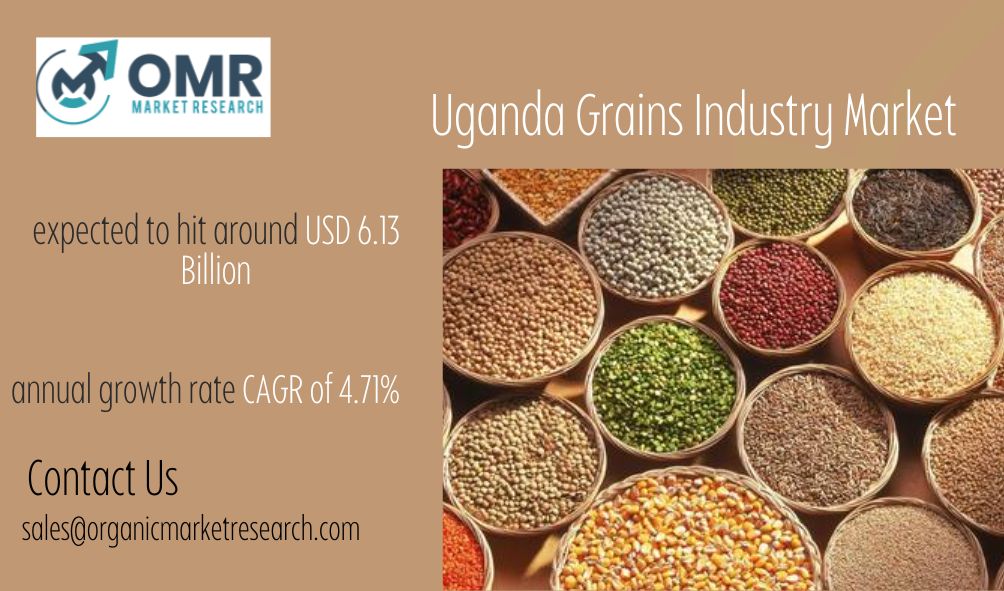Uganda Grains Industry market size was USD 4.05 billion in 2023 and the market is projected to touch USD 6.13 billion by 2032, at a CAGR of 4.71% during the forecast period. The Grains Industry sector is a very essential sector as far as food security and economic growth is concerned, this is because it employs a big number of smallholder farmers and makes considerable contributions to the country’s GDP. In Uganda, grains are grown in many Agro- ecological zones and maize is among the largest produced grain. It has continuously been produced due to its demand locally and internationally. The Ugandan grains market has experienced a lot of growth due to the increased demand for consumption and export to the neighbouring countries. The government has tried to increase the productivity of the grains sector by introducing programs like the National Agricultural Advisory Services which provide farmers with the improved seeds, fertilizes, and trains them on the best farming practices.
Uganda Grains Industry report scope and segmentation.
Uganda Grains Industry dynamics
One of the key drivers is the increasing domestic demand for food grains such as maize, millet, and rice associated with population growth and urbanization. Furthermore, it should be noted that export opportunities to other Este Africa countries, including Kenya, Rwanda, and South Sudan, play a critical role in providing momentum to the industry. Moreover, international trade restrictions associated with the COVID-19 pandemic negatively impacted industries in other countries and led to the shortage of imported grains. The government also attempts to boost the productivity of agricultural manufacturers by introducing a National Agricultural Advisory Services program, which allows farmers to receive improved seeds, fertilizers, and training. At the same time, the Ugandan industry faces some challenges. For example, the conditions of infrastructure play a critical role in the industry. Poor road networks and the absence of warehouses and storage increase post-harvest losses, reducing overall availability of grains in the country. The issue of market access also has a significant impact on industry development, particularly for smallholder farmers. Furthermore, climate variability has a negative impact on grain production, leading to crop failure or reduced yields. In order to mitigate these challenges, the industry stakeholders focusing on storage, including scaling down bulk storage solutions closer to farmers, storage management training, market access, value addition, which implies processing and packaging, and efforts to prepare an banks to lend to grain sector. Both the government and the private sector focus on the implementation of sustainable farming practices. As a result, the industry is becoming more resistant to climate change. At the same time, the government and the private sector of Uganda consistently invest in the development of infrastructure and technological improvements. Thus, stakeholders of Uganda grains will manage to achieve sustainable growth, which will impact food security and the economy of the country.
Uganda Grains Industry drivers
Increasing Domestic Demand
The rising population and rapid urbanization in Uganda are contributing factors to the growth and development of the grains industry. The hard fact is that the more people that move to the urban area increases the demand for food, mainly the staple foods that the country highly depend on such as maize, sorghum, and rice among others. These people that live in urban areas have better spending power and, therefore, the grains industry is their main beneficiary. This is because this category of people is more prone to consumption of more processed, packaged and convenience foods. Not only are the dietary patterns of people changing but also there is much education on the nutritional values of cereal grains, therefore, increasing the demand. This, on the other hand, is providing a ready and stable market for the producers to keep producing more and more for regular supplies, hence large and stable returns.
Government Support and Initiatives
Government of Uganda plays a critical role in propelling the grains industry. Various programs and policies have been set up to achieve this objective. For instance, there are the National Agricultural Advisory Services initiatives through which the government equips farmers with high quality of seeds and fertilisers. They also assist the farmers with training services to improve productivity and to ensure that there is food security. In addition, there is investment in the transport sector, especially the construction of new roads and storage facilities. This reduces post-harvest losses and enhances the mobility of the agricultural products. This essentially helps farmers expand their products and reduce cost of production. All these government investments help the farmers get higher yields thereby growing the grains industry.
- Restraints:
Inadequate Infrastructure
Lack of adequate infrastructure has remained one of the significant constraints of the grains industry in Uganda despite the government’s effort. Poor road networks and lack of enough transportation means have always hindered the smooth conveyance of grains produced from the farms to the market. As a result, a lot of costs in terms of money and time are incurred which cause a decline in competition since such grains can be spoiled to a certain degree. Moreover, inadequate storage facilities have also contributed to high rates of post-harvest losses estimated at nearly 30%. With this dire state of infrastructure in place, the grains industry has remained to stagnate with many supply chain bottlenecks which limit the budding of the industry. As a result, Ugandan grains cannot compete in either the domestic or the international markets effectively.
Climate Variability and Change
Climate variability is a huge threat to grain production in Uganda. The region receives unpredictable rains, making the grain farming industry realize either too low or too high rainfall volumes. It also experiences prolonged droughts at times that last for two seasons and high floods, which negatively affect yields. More than 80% of the grain famers in Uganda are small scale. They do not have the finance and climate information to help them use the climate-smart agriculture methods to reduce the low harvests they realize when the weather is not favourable. Undoubtedly, every significant task presents a challenge, and the inability of the industry to control the weather is manageable. What it should do is spending on research and develop drought resistant crops. To ensure a sustainable method that will not be faced out, the farmers should also be encouraged to use other climate- smart agriculture methods and realities helping each other.
- Opportunities:
Technological Advancements in Agriculture
The grains industry in Uganda is likely to benefit significantly from adopting modern agricultural technologies. The technology has several advantages, such as improving the productivity of grains, including corn, wheat, rice, and barley. Substantially, the technology exploits various modern applications such as drones and precision farming, which have significant mitigation and possible evaluation. For instance, the technology improved irrigation systems which increase productivity and reduce losses by ensuring each crop obtains optimum water. Also, mobile technology and digital advancements aid in providing market information and weather reports and agricultural practices directed at the farmers. Ideally, this incorporates some level of information into the farmer’s practice and actions, ensuring increased productivity. It can, therefore, be denoted that the modern technology associated with agriculture ensures efficient and productive grains in the industry.
- Segment Overview
The Uganda grains industry is segmented into several key categories, each playing a crucial role in the country’s agricultural landscape and economy. These segments include maize, millet, sorghum, rice, and other minor grains. Maize is the most extensively cultivated grain in Uganda, valued for its versatility in food products and as animal feed. Millet, traditionally grown across various regions, serves as a staple food particularly in rural communities due to its resilience to harsh growing conditions. Sorghum, known for its drought tolerance, is increasingly important both for human consumption and as a raw material in brewing. Rice cultivation, mainly in lowland areas with suitable water availability, contributes significantly to domestic consumption and regional trade. Other minor grains encompass a variety of crops such as finger millet, barley, and oats, cultivated on a smaller scale but offering niche market opportunities and diversified food sources.
Uganda Grains Industry market competitive landscape
Smallholder farmers are a major player in production, mainly cultivating grains such as maize, millet, sorghum, and rice in different agro-ecological zones. Their challenges include the lack of finance, inputs, and market information. Agribusinesses are also major players in the sector, investing in mechanized farming, processing machines, and value-added agricultural products. Some companies process, mill, or package grains, adding value to the raw grains and serving the diverse consumer characteristics. The businesses are able to realize economies of scale and to use modern technologies to enhance productivity and quality.
The government has established subsidies for inputs, the provision of new technologies through NAADS, and extension worker services. The Rural Markets Promotion Programme has helped in the construction of infrastructure including the perishable goods market, increasing market access and reducing post-harvest losses. I feel that government agro-processing enterprises should take a small portion of profits to buy grain from small scores at higher prices than middle-men and deposit enough food stocks, if required, in warehouses to stabilize prices on regional marketplaces.
Scope of Uganda Grains Industry report
In case you don’t find what, you are looking for, please get in touch with our custom research team at
Latest Report
https://organicmarketresearch.com/press-release/saudi-arabia-influenza-vaccine-market
https://organicmarketresearch.com/press-release/saudi-arabia-smart-meters-market
https://organicmarketresearch.com/press-release/saudi-arabia-in-vitro-diagnostics-market
https://organicmarketresearch.com/press-release/uae-green-energy-market
Contact Us
+91 9319642100
sales@organicmarketresearch.com
Noida One Tower Sec 62 Noida 201301
Website: https://organicmarketresearch.com












